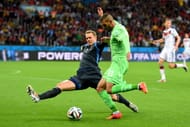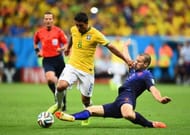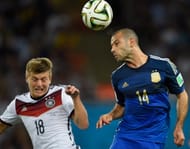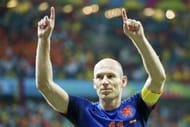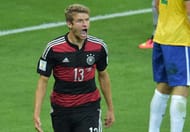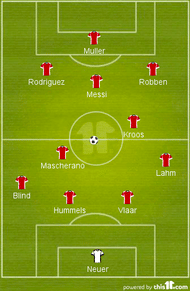The 2014 World Cup in Brazil was perhaps one of the best World Cups in recent memory. Shock upsets? Check. Barely believable score lines? Check. Penalty shoot-out drama? Check. Sublime goals? Check. Inhuman goalkeeping performances? Check. Teams being utterly reliant on one player and being found out without that player? Check. Refereering controversies? Double Check.
On top of all this, there were also some cracking games in a World Cup that saw 171 goals – the joint-highest in a World Cup with 1998. There were also some players, who showed just why they are one of the best in the business.
So, let us take a look at who gets into the Team of the tournament.
Goalkeeper: Manuel Neuer
This was arguably a tournament that was dominated by stellar goalkeeping performances. Whether it was Tim Howard’s world-record breaking efforts against Belgium or Keylor Navas’ heroics helping his side to the quarter-finals, the tournament wasn’t short on sublime shot-stoppers. So it wasn’t an easy job picking the best keeper, but I went for Manuel Neuer, only just ahead of Navas.
Neuer takes his place in this lineup thanks not only because he won the Golden Glove but also for keeping Germany in the game on plenty of occasions. His unorthodox style has certainly worked for the Germans as they won their first World Cup in 24 years. Whether it is sweeping up the play outside the box, making critical lunging tackles, stopping rasping drives with just one hand or launching attacks with his long throws, Neuer has without a doubt been the best goalkeeper in Brazil.
Defenders: Phillip Lahm – Ron Vlaar – Mats Hummels – Daley Blind
Phillip Lahm started the tournament in central midfield as his coach was trying to get Sami Khedira and Bastian Schweinsteiger into full fitness. In the three group games, Lahm was phenomenal. His work-rate and ability to help out in both attack and defence really set the tone for the side. But, ever since he moved to right back, he has arguably gotten even better. Whether it is timing his runs into the opposing half or his tackles inside his own, Lahm has shown just why he is the first-name on the team sheet for Germany.
Before the start of the tournament, few would have predicted that Ron Vlaar, or “concrete Ron” as he is fondly known, would finish as one of the tournament’s best centre backs. The Aston Villa centre-back was given the responsibility of leading a largely inexperienced defence for the Dutch. And lead them he did. Vlaar averaged 2.4 tackles, 3 interceptions and 9 clearances per game. And he was a man-mountain in a three-man defence. Barring his penalty miss in the shoot-out against Argentina in the semi-final, Vlaar was faultless and deserves his place in the side.
While Vlaar was without a doubt the best defender in Brazil, there was someone who combined his ruggedness in defence with some finesse going forward. Germany’s Mats Hummels just had two shots on target in the entire tournament, but scored with both of them and at crucial times too. The 25-year-old was the stereotypical modern centre back – solid in defence and highly capable of bringing the ball out from the back.
Modern full backs are required to be fast, good in the air and be capable of going forward at every opportunity. While Daley Blind might not check the first two boxes, his position as the second-leading assist maker in the tournament certainly justifies the last one. He started the tournament as a left wing back, but by the end of it, he had played as a defensive midfielder, left back and a left-sided centre back. And not for one moment did he look out of place in either of those roles and that is precisely why he makes it into this team.
Central Midfield: Toni Kroos – Javier Mascherano
The least experienced of Germany’s central midfielders turned out to be their best as 24-year-old Toni Kroos played a crucial role in helping his side dominate the midfield, which eventually led to them claiming their first World Cup since 1990. Given the freedom to venture forward, Kroos made utmost use of this as he notched up two goals and three assists to finish as his side’s most productive attacking threat from midfield. Apart from the numbers, Kroos’ ability to pick out a team-mate who is in a tight spot and launch fast counter attacks was a key reason in him being the tournament’s standout central midfielder.
But if there is one player that deserves that acclaim as much as Kroos, then it is none other than Javier Mascherano. He was Argentina’s unsung hero in midfield, and the ease with which he broke down the opposition’s attacks and started an attack of his own was simply stunning. Often bracketed as a defensive midfielder, Mascherano showed that his distribution of the ball is criminally under-rated and was the linchpin that brought together the defence and the attack. While Messi got all the plaudits, it was Mascherano who did all the dirty work to get them to the final.
Attacking midfield: Arjen Robben – Lionel Messi – James Rodriguez
His theatrics aside, Arjen Robben was perhaps the most potent attacker in Brazil. Every time his side got the ball, they instinctively looked for Robben, for they knew what a threat he was. It wasn’t just his ability to get past his markers as if they didn’t exist, but the fact that he kept on going and going and going, right until the final whistle showed his superhuman levels of endurance. Aged 30, he might not get another shot at a World Cup, but he certainly enthralled and exasperated fans and players alike with his performances in Brazil.
Such is the standard that Lionel Messi sets himself that some might call his inclusion unwarranted. But the simple fact is that without Messi’s contribution, Argentina would have been nowhere near the final. Even though he was almost anonymous in the final, he still almost won them the game. Although he wasn’t able to win the World Cup like Diego Maradona did, he showed some sublime bursts of individual brilliance, even if he didn’t deserve the Golden Ball.
The breakout star of Brazil was Colombia’s James Rodriguez. Even though he had made a big-money move to AS Monaco only the previous season, not much was known about him. But thanks to 6 goals, 2 assists and some eye-catching displays, another global superstar was born. His wonder goal against Uruguay showed everything he was all about - vision, grace, technique and the courage to never be afraid of trying his luck. From being a relatively unknown to being a household name, James Rodriguez certainly showed the world just why Monaco splashed the cash to bring him to the principality.
Striker: Thomas Müller
Aged just 24, with 10 World Cup goals to his name already, it seems like it is only a matter of time before Thomas Müller surpasses Miroslav Klose’ World Cup goal scoring record. In Brazil, Müller espoused German efficiency above all else. His versatility and ability to conquer space meant that he was always available for a pass and provided an outlet for the German attack throughout the tournament. He might not be the most eye-catching player, but when it comes to offensive productivity, there are few who can beat him and be at the right place, at the right time.
Substitutes: Keylor Navas, Stefan de Vrij, Ezequiel Garay, Giancarlo González, Ricardo Rodriguez, Neymar, Alexis Sánchez
Coach: Joachim Low
For not just being the first German coach to bring home the World Cup for his country since 1990, but for also realizing when tactical tweaks needed to be done and being bold enough to make tough calls. Whether it was shifting Lahm from central midfield to right back or bringing Miroslav Klose in for the knockout games, Loew had the magic touch that helped his side to victory.
